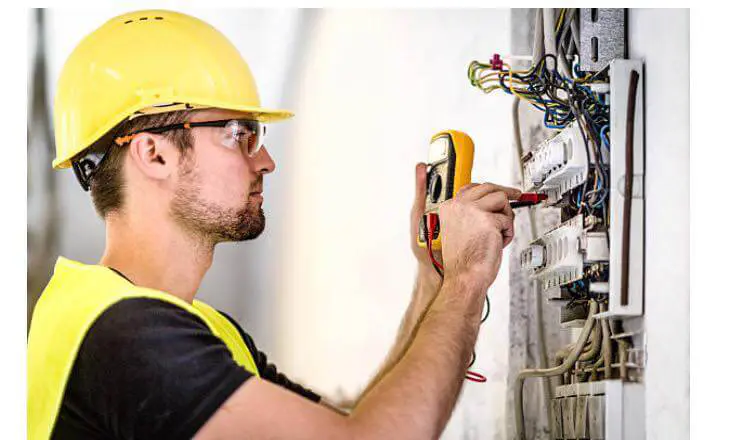‘As the saying goes, ‘Prevention is better than cure.’ This holds especially true when we’re dealing with electrical installations in our rental properties. As landlords, we’re legally obligated to get an Electrical Installation Condition Report (EICR), but it’s not just about ticking off a box. I’ve found it’s a critical tool for avoiding hazards, potential tragedies, and expensive repairs down the line.
However, the process can be a bit tricky to navigate. So, how do we ensure we’re doing it right and what should we look out for? Let’s discuss.’
Understanding EICR
Delving into the world of property management, one must grasp the concept of the Electrical Installation Condition Report (EICR), a crucial document that ensures the safety and compliance of the electrical installations within a property.

An EICR is an in-depth assessment, carried out by a competent professional, that involves electrical testing and fault inspection. The objective is to ascertain the safety of the property’s electrical system and identify any areas that require attention or improvement.
It’s part of a landlord’s obligations to maintain safe living conditions for their tenants. By adhering to these safety measures, landlords not only ensure their properties are up to standard but also provide essential tenant protection. Understanding and implementing an EICR is key to successful property management.
Responsibilities and Legal Requirements
As a landlord, it’s crucial to understand your legal obligations and responsibilities when it comes to EICR. This includes tenant notification about upcoming EICR inspections, coordinating access to the property, and ensuring legal compliance.
I’m legally obligated to arrange for an EICR every five years, or when a new tenant moves in. If the EICR identifies any issues, I must take prompt remedial actions to correct them. Once the remedial actions are completed, I’ve to obtain a valid certificate confirming the electrical safety of the property.
Failure to comply with these responsibilities can result in severe penalties, including hefty fines. Therefore, understanding and complying with these EICR-related responsibilities and legal requirements is absolutely essential for me as a landlord.
EICR Inspection Process
Now that we’ve talked about the legal responsibilities, let’s move on to the actual EICR inspection process which involves a series of systematic steps to ensure the electrical safety of a property.

Initially, there are key preparation steps, such as clearing the area for easy access to all electrical systems. The inspection then commences with visual checks, followed by comprehensive electrical testing. This includes fault identification, to spot any potential hazards or non-compliance issues.
After the inspection, remedial actions are taken based on the identified faults. This might be as simple as replacing a socket, or could involve more extensive work. Understanding this process is crucial as it directly impacts the safety of your property and compliance with legal obligations.
Post-Inspection Actions
Once the EICR inspection is complete, it’s crucial to promptly address the ‘post-inspection actions’ – a term referring to the steps taken to ensure any identified faults are rectified for overall safety and compliance.
This process begins with receiving the report, meticulously examining it to understand the classification codes and the severity of the issues detected. Addressing these issues is a mandatory step, which may involve multiple remedial actions, such as repairing faulty wiring or replacing outdated electrical components.
Once the necessary corrections are made, it’s essential to re-evaluate the property to ensure it meets the required safety standards. On satisfactory completion of these steps, you’d be obtaining the certificate, which attests to the electrical safety of your property.
Importance, Consequences, and Benefits
Having addressed the post-inspection actions, let’s shift our focus to understanding why EICRs are so important for landlords, the potential consequences of non-compliance, and the myriad benefits that come with diligent adherence to these safety protocols.
Tenant safety is paramount and EICRs facilitate this by identifying electrical hazards that could compromise wellbeing. Failure to comply with EICR regulations can have serious insurance implications, not to mention potential legal penalties.
On the flip side, diligent attention to EICR requirements can enhance property value by ensuring the installations are safe and up-to-date. Beyond that, knowing your property meets safety standards brings a priceless landlord peace of mind.
Lastly, EICRs can aid in cost prevention, as early identification of electrical issues helps avoid major, costly repairs in the future.
Frequently Asked Questions
What Are the Qualifications Required for an Electrician to Conduct an Eicr?
To conduct an EICR, an electrician needs specific training and certification, verifiable by a relevant body. Understanding EICR costs, dispute resolution, and insurance implications are also integral to their professional competence.
How Long Does an EICR Inspection Normally Take for a Standard Residential Property?
An EICR inspection for a standard residential property typically takes 4-6 hours. However, it can vary based on the property’s size, age, and complexity of the electrical system.
Are There Any Specific Signs or Indications That Suggest an EICR Inspection Is Urgently Needed?
I’d say frequent tripped fuses, flickering lights, or any electrical shocks suggest an urgent EICR inspection. It’s about tenant safety, avoiding non-compliance penalties, and handling EICR costs properly with thorough documentation.
What Can Landlords Do to Ensure They Are Prepared for Future EICR Inspections and Maintain Compliance?
I’m always prepared for future EICR inspections by maintaining compliance checklists, setting regular inspection frequencies, engaging my tenants, keeping up-to-date documentation, and taking preventative measures. This proactive approach ensures I meet all regulatory needs.
Can a Landlord Perform Their Own EICR if They Are a Qualified Electrician?
As a landlord and qualified electrician, I can perform my own EICR. However, it’s crucial to uphold safety standards, consider legal implications, and objectively evaluate inspection costs to maintain electrician’s credibility and landlord responsibilities.
Conclusion
In conclusion, understanding and complying with EICR regulations is non-negotiable for landlords. It’s not just about obeying laws, but also about ensuring tenant safety and preventing costly future repairs.
The inspection process may seem daunting, but with a clear grasp of your responsibilities and the right actions post-inspection, it becomes manageable.
Remember, a safe property is a profitable property. Keep learning, stay updated, and maintain high standards of safety for the well-being of your tenants and your investment.









